Graduate Student Spotlight Archive
Kevork Oliver Messerian
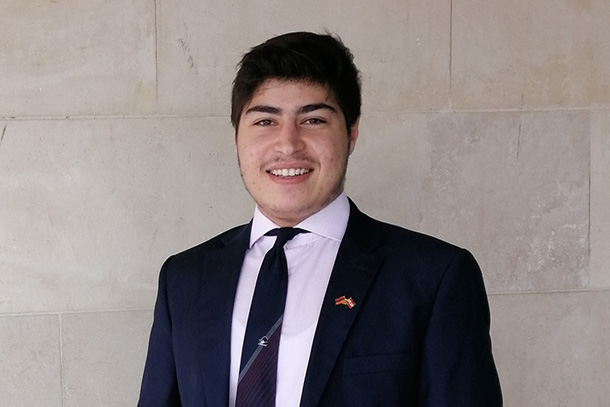
Kevork Oliver Messerian is a third-year doctoral student who works with Andrew Zydney, Bayard D. Kunkle Chair and professor of chemical engineering. His research involves studying the sterile filtration of lipid nanoparticles for mRNA vaccines and therapeutics. He earned his bachelor’s degree in chemical engineering from the University of Balamand in Lebanon, where he worked on evaluating the water footprint scarcity and process design for pineapple juice produced locally.
Messerian said one of his favorite things about Penn State, other than it being a world class University with academic excellence, is the diversity it holds within the student body. He said having a large number of international friends has not only helped him feel more welcomed, but also gave him the opportunity to build a strong network. On a larger scale, he said he believes that the United States as a whole is full of opportunities that he would not have had if he had pursued his doctoral degree somewhere else.
When Messerian pursued internship opportunities, he discovered many research areas that the world of chemical engineering has to offer, such as petroleum, food and pharmaceuticals. Eventually, he decided to settle in the research area of pharmaceuticals. He chose Penn State chemical engineering because the department offered a variety in research themes, especially in the biotechnology sector. He said he is fond the new department building, which also motivates and entices him to perform research. He said he also feels the department’s Graduate Student Association does a fantastic job at taking care of the graduate students by organizing several events — symposiums, tailgates, etc. — along with weekly, much-needed coffee hours.
Outside academic and research life, Messerian likes to spend time in the gym, hanging out with friends and cooking food. He also recently joined the chemical engineering graduate student association, where he serves as a secretary. His favorite activities are hiking and skiing, which are both convenient to do in State College. Messerian said after graduation he is looking to develop his career in industry where he will use the knowledge, skills and education received from Penn State to become a great future professional.
Hoang "Bolton" Tran
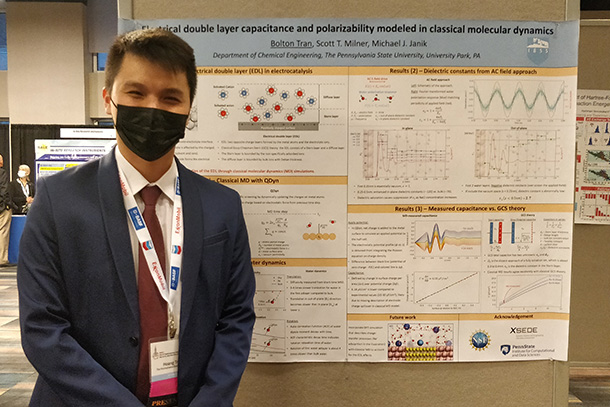
Hoang “Bolton” Tran is a fifth-year doctoral student working with Michael Janik, acting department head and professor of chemical engineering, and Scott Milner, William H. Joyce Chair Professor of Chemical Engineering. His research involves developing a computational approach that ranges from quantum to classical mechanics to model the complex electrode-electrolyte interface. Tran completed his undergraduate studies in chemical engineering at Drexel University in Philadelphia, where he briefly worked on depositing semiconductor thin films for solar-cell applications with Jason Baxter, professor of chemical and biological engineering. Post-graduation, Tran worked at Avid, a radiopharmaceutical company, for a year before deciding that he wanted to pursue graduate school. He has been in the U.S. for 10 years now, where he has learned to appreciate the perks of living in a developed country: safety, infrastructure, entertainment, free speech, and of course, top-notch academia. However, he said he still feels he belongs in his hometown Saigon in Vietnam. He could spend the next 20 years settling down here in the U.S. but would still consider himself a son far from home. He misses Vietnamese food cuisine, especially a bowl of Bun Bo, which he can eat any day of the week.
He chose Penn State chemical engineering because he feels the department offers a challenging doctoral program. He would think of a scenario where he would not have pursued graduate school but instead moved back home with a decently paid job, eating Bun Bo every day. In contrast, he decided to pursue graduate school, where he works more than eight hours a day in the lab, eating a quick lunch every day because he needs to get back to work, racking his brain on why his simulations are not working, getting anxious on a paper that keeps receiving poor reviews and feeling like an impostor every once in a while. Yet, he understood that there must be challenges to make the pursuit of a doctoral degree ultimately worthwhile.
Tran emphasized that Penn State faculty and fellow students have provided him with ample support to meet those challenges and make the graduate school experience much more pleasant. He said he has really enjoyed working with the faculty at the chemical engineering department, especially his advisers. He said they never fail to instill a sense of purpose in him and always emphasize the significance of his work. Because of that, he feels satisfied with the work he does. Tran also said his advisers frequently express their sympathy and give support to international students. He feels that his personal hardship is always heard and seen by them. He also credited his peers for making his graduate school years much more enjoyable and memorable.
Outside his academic life, Tran has started a mini-student organization for Vietnamese graduate students. He said he hopes to bring Vietnamese graduate students on campus together to bond and share the hardship of graduate school. This group currently has around 10 members and is growing. He is also a senior member in RAM, a student-run hip-hop/freestyle dance organization on campus. He trains new members, holds occasional workshops, and choreographs dance performances for various campus events, including THON. In his free time, Tran enjoys visiting Philadelphia and Washington, D.C.
After graduation, Tran plans to pursue a postdoc position and eventually receive a faculty job at a university.
Prawal and Puja Agarwala
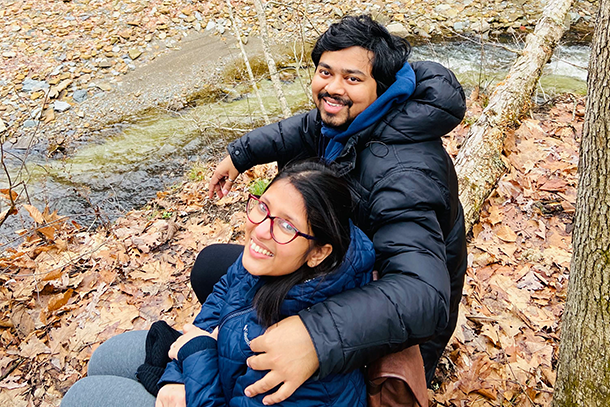
Background information:
Prawal is from Agra—the city of Taj Mahal—in India and attended Harcourt Butler Technological Institute, Kanpur for his undergraduate degree in chemical and food technology. Puja is from Lalgola, a small city on the shores of Padma River in India, right near the Bangladesh-India border and attended Jadavpur University, Kolkata for her undergraduate degree in chemical engineering. They both did master’s in chemical engineering from Indian Institute of Technology, Bombay and are both pursuing their Ph.D. from Penn State.
Prawal was in his second year of his master’s program when he met Puja, who joined the same lab as Prawal. While working together on exciting research problems related to Janus particles, they spent a lot of time together doing experiments in lab and discussing research. They are now married.
How did you like your time there and what activities did you take part in?
Prawal : It was an excellent time for learning and trying new things in life. I participated in various activities like singing and worked as a cultural head of the institute for a year during my undergraduate studies. We organized several inter- and intra-collegiate cultural festivals. During that time of my life, I learned a lot about managing many people, organizing programs, judging diverse talents and excelling in different aspects of life. During my time at IIT Bombay, a beautiful campus near Powai Lake, I enjoyed playing cricket, eating at various places inside the campus and going for long night walks. I worked as a cultural secretary for the chemical engineering department and motivated the graduate students to participate in cultural activities.
Puja : My experience was very different in both the universities. During my undergrad, I lived off campus and stayed with students from other universities. It was an enriching experience learning about law, accounts and finance from them and sharing science facts. At the university, other than my studies, I was a part of the classical dance group and performed in various cultural programs throughout the program. I also taught mathematics to school students. I loved exploring the street food of Kolkata. During graduate school, I stayed on campus, and IIT Bombay provided a platform for both curricular and non-curricular activities, which was an enriching experience. I was the cultural coordinator of the Department of Chemical Engineering, and during my tenure, the department ranked third out of 25 departments. I also volunteered at various events and performed in dance shows. My favorite thing to do in Mumbai was to sit quietly near the sea.
What inspired you to become a chemical engineer?
Prawal : In high school, I had so much interest in chemistry—mainly organic chemistry. We used to choose different reactions and try to write their mechanism on the whiteboard. It was like playing Pictionary. We had to guess through which pathway the reactant converted into the product. We also used to solve physical chemistry puzzles in kinetics, thermodynamics, and chemical equilibrium. This led to a rising interest in chemical engineering, and my undergraduate experience strengthened my motivation to study various chemical processes leading me to earn a master’s degree. After teaching chemical engineering at a university in Mumbai for four years, I decided to go for cutting-edge research by pursuing a Ph.D. in chemical engineering. The field is so broad that we can learn so much from it. I believe that there is nothing a chemical engineer cannot do. They can excel in every field.
Puja : My curiosity to understand various natural phenomena and love for mathematics led me to choose science and subsequently chemical engineering.
What is your research about now and what drew you to the project?
Prawal : I am working with Themis Matsoukas, professor of chemical engineering, for the U.S. Department of Defense on various projects related to metal-based nanoenergetic materials. We invent different approaches, including non-thermal plasma technology, to enhance the reactivity and energy release of metal nanoparticles for using them in energy applications, such as solid fuels and rocket propellants. I was motivated by the application-based nature of this research. We synthesize material, test them in our labs using material characterization by employing efficient techniques and supply the material to Naval Research Center to test them in real-life applications, which is fascinating for me. Moreover, working with Professor Matsoukas is inspiring and fun because he looks at the problem with a unique perspective and suggests an advanced approach.
Puja : I am developing simulation methods to obtain the physical properties of semiconducting polymers. Undergraduate courses in high polymer technology and interfacial science and technology developed my interest in this field of research, and I pursued the same area of research in the master's program. When I came here, I was looking forward to application-oriented research in polymer and Interfacial science, and semiconducting polymers have enormous industrial applications. I was particularly excited to work with Scott Milner, William H. Joyce Chair Professor of Chemical Engineering, and Enrique Gomez, professor of chemical engineering.
What activities do you enjoy doing together?
We love to play badminton together daily and go for long walks. We both are food enthusiasts and experiment a lot with cooking. We love to organize musical nights, dance nights and potlucks on weekends.
What are your plans for after you graduate?
We want to work in research and development as a professor or scientist and aim to benefit humankind through our ideas, combined knowledge of engineering and science, hard work and learning abilities.
What is your dream vacation?
Traveling is one of the most exciting and rewarding experiences that life can offer. Prawal’s dream vacation is to travel to Greece, and Puja’s is to go to Norway to watch the northern lights.
Matthew Billups

Matthew Billups’s path to studying engineering began in a physics class where the teacher showed an old video that demonstrated how an open differential allows automobile wheels to turn at different speeds. Billups said this awesome experience, while to some could seem obvious or unimportant, caused him to reflect on how “how and why” things work the way they do. This sparked his passion for automotive mechanics, which still exists to this day. He said it also inspired him to apply this same principle to his strengths in mathematics and chemistry by joining the chemical and biomolecular engineering undergraduate program at Johns Hopkins University in 2012. When he wasn’t using his seven-foot wingspan to block shots as a captain of the men’s basketball team, he said he quickly realized he was particularly interested in the manufacturing and industrial applications of his chemical engineering education. With that, he decided that the most fulfilling career path would be manufacturing and process design in the pharmaceutical industry.
Billups continued his education at Rutgers University from 2016 to 2018, where he pursued a master's degree in chemical engineering while doing research in the Engineering Research Center for Structured Organic Particulate Systems. During this time, he completed a master’s thesis on material traceability and modeling of powder feeding in continuous tablet manufacturing with Ravendra Singh. During this time, he was hired for a six-month internship at Janssen Pharmaceuticals in Spring House, Pennsylvania, where he was responsible for designing real-world scenario analysis and design space exploration of a fluid-bed granulation model for legacy products being brought online at a new plant. Billups said it was during this time that he was inspired by his colleagues to pursue a Ph.D. and shift his focus to the manufacturing and process development of biotherapeutics. He came to Penn State to work towards earning his Ph.D. and work with Andrew Zydney, Bayard D. Kunkle Chair and professor of chemical engineering, to pursue his goals in the field of biopharmaceutical manufacturing.
His Ph.D. project is focused on the downstream processing of therapeutic monoclonal antibodies (mAbs) for drug production. mAbs are a key class of biotherapeutic drug that require high purity and safety due to their intravenous administration to patients. Billups is specifically focusing on using polymer membranes to allow the mAb product to pass through the filter and retain any viral contaminant which may be present. Billups is working directly with Bristol Myers Squibb to study three different mAbs that pass through the virus filter with varying degrees of flux decline, with the goal of identifying the mechanism of the flux decline and the key mAb parameters that predict this behavior. He has used different sized membranes, configurations, and orientations to demonstrate the role of membrane structure in the fouling mechanism of mAbs. Additional experimental techniques, such as dynamic light scattering and hydrophobic interaction chromatography, were used to characterize the feed streams in an effort to determine how self-association of mAbs impacts the flux. Billups said he is motivated by discovering the “how and why” to unanswered questions in the field of downstream processing of biotherapeutics.
One aspect of State College that Billups said he enjoys is his access to nature. He enjoys camping and going on hikes with his partner, Julia, and dog, Cody. After the pandemic began, he embraced the hobby of mountain biking and said he was pleasantly surprised by the number of local trails hidden in plain sight. When he is not working on his research, you might see him flying by you on the trail or at the Penn State Bike Den fixing and maintaining his bike.
Niladri Sekhar Mandal
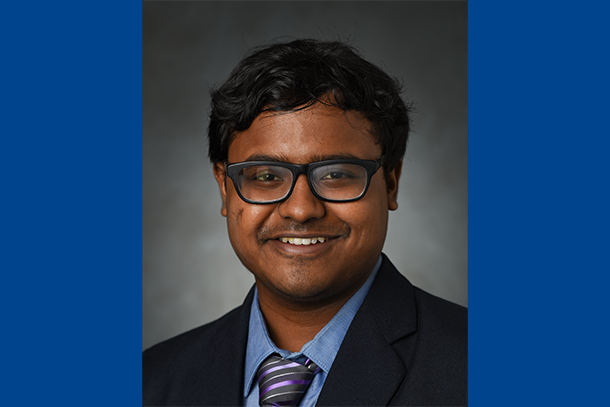
Niladri Sekhar Mandal has always been interested in math, chemistry and physics, but chemical engineering initially was not a passion — rather, a choice that stemmed from practicality. During his time at Indian Institute of Technology—Delhi, he entered a dual-degree program to receive his bachelor's and master’s degrees in chemical engineering in five years. For his master’s degree thesis, he studied gas diffusion through polymer films impregnated with solids, such as nanoparticles. Mandal also completed an internship at Unilever, where he said the steep learning curve was a challenging but eye-opening experience. It also demonstrated the importance of interdisciplinary work on finding new perspectives. He said these two experiences gave him the desire to dive deeper into the field of chemical engineering and pursue his doctorate.
Mandal said he also vividly remembers a lecture in his introduction to biology class as an undergraduate. The professor was discussing how the ATPase enzyme acts as a molecular motor while it converts ATP to energy. He was captivated with how a purely biological system could be acting as a mechanical system to produce energy within each cell. This class was a driving force on why he chose to work with Ayusman Sen, Verne M. Willaman Professor of Chemistry, for his Ph.D. project on enzymatic chemotaxis, focused on understanding and applying how enzymes respond to environmental stimuli. Enzymes and other small particles normally move based on Brownian motion and diffusion, but enzymes have recently been found to move faster than they are able to diffuse and in a distinct direction when searching for “substrates.” Mandal’s research looks to understand and utilize this phenomenon for applications such as targeted drug delivery within the human body.
Outside the lab, Mandal is a delegate to the University’s Graduate and Professional Student Association, which is the legislative body for graduate students at Penn State. As a member of the GPSA, he has done extensive work improving and providing resources for professional development of engineering graduate students at Penn State. He has helped run and organize events such as writing workshops for papers and theses, LinkedIn workshops, professional headshots and career seminars. He said he believes every engineering student should be able to complete an internship during their time in school to help boost their education through experiential learning. While he does not know if he wants to go to industry or academia after he graduates, Mandal said he knows that he wants to continue to solve scientific and engineering problems with practical applications while keeping his intellectual freedom and being able to satisfy his scientific curiosity. Wherever he can find that balance, he will be satisfied.
Natalie Thompson
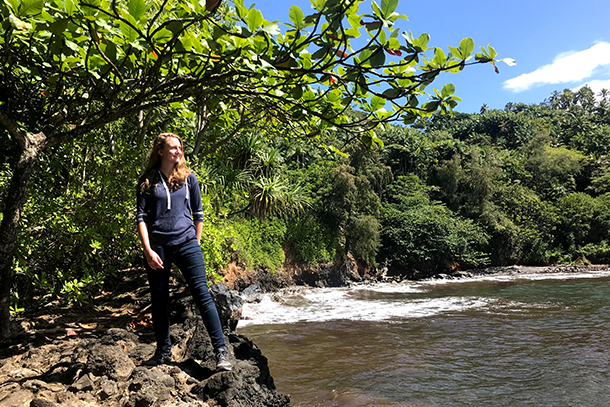
Natalie Thompson is the youngest of four children, all of whom were homeschooled by her parents, who are both chemists. Since Thompson was the youngest, by the time she was in middle school “all the reins were off” when it came to the curriculum that her parents taught her, which gave her the freedom to pursue the subjects of her choice and that were of greater interest to her. At the time, this meant she took a lot of extra chemistry and math courses, and she took chemistry lab courses at a local community college when she was 16 years old to get hands-on experience in the lab. Before graduate school, she hated biology because it was unpleasant to think about bones and organs. Thompson preferred to think about the human body as being made of cement and rebar in order to avoid thinking about what was actually happening inside of organisms’ outer shells. That changed when she came to Penn State’s Chemical Engineering Graduate Open House and met Wayne Curtis, professor of chemical engineering.
Curtis works on experimental plant and system biology, using insects as viral vectors for gene therapy in plants. What really changed Thompson’s opinion on biology was seeing how it was possible to genetically engineer the function of a virus, which is traditionally associated with negative connotations of infection, to be a vessel for positive changes to the “infected” host. Her Ph.D. research optimizes the adaption and reaction of plants to abiotic stresses, such as drought, through the use of gene therapy, which is delivered by whiteflies. To understand the delivery of the viral vector to the plant and minimize off-target effects, she is also undertaking mathematical modeling of the whitefly colonies, which is where the expertise of her co-adviser, Antonios Armaou, professor of chemical engineering, comes in. Thompson uses ImageJ and MATLAB to model how the colony interacts with itself, and she will be extending that model to incorporate how the colony interacts with plants and viruses in the future. She said she is now fascinated by biology because of how complex of a machine it is, and despite humans having researched these biological systems for so many decades, she said there is still so much to learn and discover.
After graduation, Thompson plans to go into the pharmaceutical industry to focus on increasing the efficiency of current processes and helping people by pushing those savings onto the consumer. She said her life goal is to flip the paradigm in the pharmaceutical industry that pushes profit over consumer health. Once she has completed that and is ready to “retire,” Thompson said she hopes to return to academia to be an adjunct professor and teach students from a more real-world perspective and inspire other women engineers. Thompson’s favorite professor at Worcester Polytechnic Institute, where she earned her undergraduate degree, was an adjunct professor that had multiple decades of experience in industry. They were able to draw upon for the courses, and she said that the professor framed the courses in a way that enhanced her learning and desire to be a chemical engineer.
Rachel Taylor
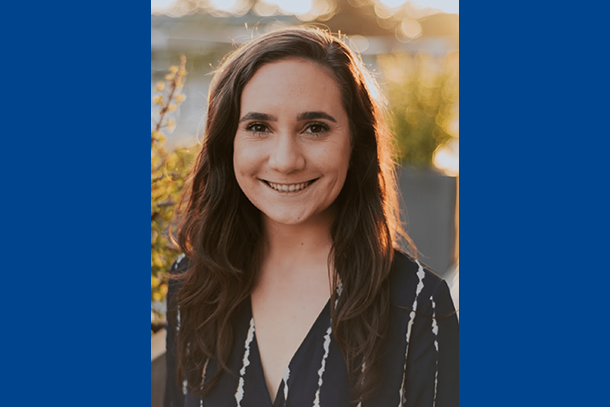
Rachel Taylor’s scientific journey began when she was just 15 years old and took a two-week expedition to the Peruvian rainforest, organized by Earthwatch. In Peru, she worked with an international group of researchers on examining the impact of rising water levels on the riverbank ecosystem. From there, she ventured into wildlife preservation and education while working at the San Francisco Zoo until she finished high school. It was at that point that she realized she wanted to be a part of the movement to help address and create solutions that she had been exposed to during her time studying the impacts of climate change. That was when she decided to become a chemical engineer at the University of California, Santa Barbara (UCSB).
Taylor said she enjoyed her time at UCSB. She said the proximity to the sunny beaches of southern California was an essential lifeline of mental escape during times of stress of the rigorous chemical engineering curriculum. She conducted research in the lab of Arnab Mukherjee, assistant professor of chemical engineering at UCSB, working on molecular imaging and engineering of anaerobic proteins. She said while she loved the experiments that she ran because she was creating and manipulating microscopic organisms every day in the lab, the work was too far removed from her ultimate goal of aiding in humanity’s quest to fight climate change.
Once Taylor arrived at Penn State, she joined the lab of Bruce Logan, Kappe Professor of Environmental Engineering and Evan Pugh University Professor, to study thin-film composite membranes for seawater electrolysis. Her work will help understand the mechanisms that influence ion transport through membranes in the presence of an electric field and will help reduce the cost of hydrogen production by reducing the need for high-purity water as a feedstock. Taylor said she loves being at Penn State because of the wealth of opportunities for her to have an impact and collaborate with others. For example, she will be a visiting researcher in the lab of Cristian Picioreanu, professor of environmental science and engineering at the King Abdullah University of Science and Technology in Saudi Arabia. Taylor said she will be constructing a numerical model for ion transport through thin-film membranes in an electric field, and maybe going to the beach once or twice.
Liang-Kai Chu
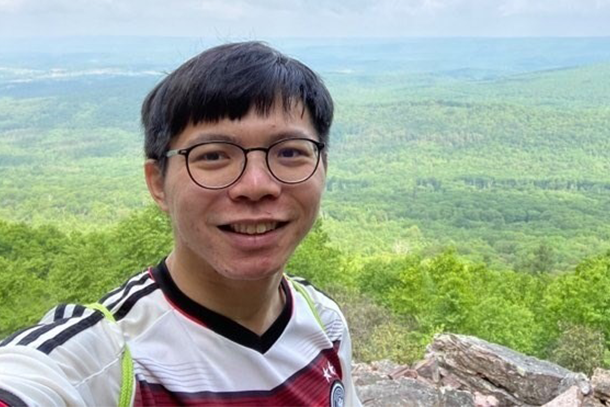
Liang-Kai Chu is a third-year graduate student working on membranes for the pharmaceutical industry with Dr. Andrew Zydney. Che is the mentorship chair for the Chemical Engineering Graduate Student Association.
Chu is from Taiwan. He received his bachelor’s and master’s degrees in chemical engineering from the National Taiwan University (NTU). Chu was initially drawn to Penn State for his doctoral degree because of the University's quality, high research output, and its exceptional research facilities. However, the people and available possibilities sealed the deal for Chu.
Penn State’s large Taiwanese community played a large role in his decision to come to Penn State for his doctorate because it provides a reminder of home despite being an ocean and a continent away. The diverse research portfolio and extensive alumni network at Penn State also heavily influenced his decision because they would allow him to develop a large set of skills and set him up for success when transitioning into industry after his doctorate.
During his time at NTU, Chu researched catalysis and thermodynamics. While he enjoyed the research process, which motivated him to continue to get his doctorate, Chu learned that those topics were not quite his style due to their more niche nature. Since arriving at Penn State, Chu's research in the Zydney Lab has been on characterization and evaluation of membranes for virus purification and depth filters for in-process filtration. Chu enjoys the quick feedback from research experiments to data analysis and the large-scale application and impact of the work that he is doing.
Moving from the big metropolises of Taiwan to the town of State College was definitely a stark transition, but Chu enjoys the nature and outdoor activities that are easily accessible within Central Pennsylvania. He has learned how to fish and has taken on multiple fishing trips with friends inside and outside the chemical engineering department. Chu also enjoys hiking—he has a list of all the trails and state parks within a two-hour radius and is trying to visit each one before he graduates. To remind himself what city life is like, he has taken multiple trips to places like New York City and New Orleans over the past few years. While he misses the hustle and bustle of the big city, he also enjoys the quiet life that State College provides.



